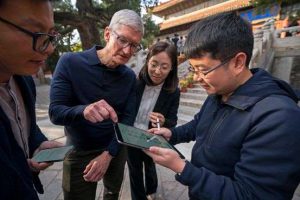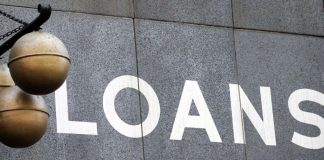MARCH 2, 2020

Long before Donald Trump moved into the White House or the coronavirus paralyzed the city of Wuhan, Apple Inc.’s operations team began raising concerns about the technology giant’s dependency on China.
Some operations executives suggested as early as 2015 that the company relocate assembly of at least one product to Vietnam. That would allow Apple to begin the multiyear process of training workers and creating a new cluster of component providers outside the world’s most populous nation, people familiar with the discussions said.
Senior managers rebuffed the idea. For Apple, weaning itself off a stubborn dependency on China, its second-largest consumer market and the place where most of its products are assembled, has been too challenging to undertake.
Apple’s addiction to manufacturing in China has long frustrated staff—and more recently unnerved investors. The coronavirus represents Apple’s third major setback there in as many years, including the fallout from tensions with the U.S. that included tariffs and slower-than-expected iPhone sales in the country.
Factory production has been crippled as China has shut down activities and sought to contain the outbreak, and Apple warned investors it won’t meet its own sales estimates in the current quarter. Since that warning, Apple’s market value has declined by more than $100 billion.
“No executive will admit in a public forum: We should have thought about” the vulnerability to China, said Burak Kazaz, a Syracuse University supply chain professor and former researcher at International Business Machines Corp. “But from this point on, there are no excuses.”
China has been a critical factor in Apple’s once-soaring $1.4 trillion market value. The country provides a stable, efficient, low-cost manufacturing base with an abundant network of suppliers that have helped cement Apple’s profitability.
Apple Chief Executive Tim Cook continues to play down the need to significantly change Apple’s supply chain. During an interview Thursday with Fox Business Network, he said unpredictable events are a facet of modern business and noted that Apple’s operations team has previously navigated earthquakes, tsunamis and other challenges.
“The question for us is: Was the resilience there or not? And do we need to make some changes?” Mr. Cook said. “My perspective sitting here today is that if there are changes, you’re talking about adjusting some knobs, not some sort of wholesale fundamental change.”
Apple has recently started to experiment with small production moves out of China. These attempts, including plans to assemble wireless earbuds in Vietnam and produce iPhones in India and Mac Pro computers in the U. S., have laid bare a number of difficulties.
A clean break with China is impossible. Apple relies on a workforce of more than three million indirect workers in China.
Its top manufacturer, Taiwan’s Foxconn Technology Group, hires hundreds of thousands of seasonal employees in China, many of whom manually insert tiny screws and thin printed circuit boards during the iPhone assembly process, people familiar with the process said. Tens of thousands of experienced manufacturing engineers oversee the process.
Finding a comparable amount of unskilled and skilled labour is impossible, said Dan Panzica, a former Foxconn executive.
The population in China has allowed suppliers to build mega-factories with a capacity for more than 250,000 people. The number of migrant workers in China, who do much of Apple’s production, exceed Vietnam’s total population of 100 million. India is the closest comparison, but its roads, ports and infrastructure lag far behind those in China.
“You’re not going to be able to have mega-factories anywhere else,” Mr Panzica said. “You’re going to have to break them up.”
Moving out could also jeopardize Apple sales in China, which counts for nearly a fifth of its total revenue. Employing so many local workers helped the company gain access to the market and any reduction might weaken its standing with the government, which wields tremendous influence over how global brands are perceived, according to Neil Mawston, a technology researcher with the firm Strategy Analytics.
Though Apple’s brand remains strong in China, its share of the smartphone market has declined to 7.5% from a peak of 12.5% in 2015 because of pressure from homegrown rivals such as Huawei Technologies Co., according to Canalys, a market research firm.
Mr. Cook, who joined the company in 1998, is the architect of Apple’s China business. As head of operations, he assumed responsibility for a company saddled with extra inventory and reliant on its own U.S. manufacturing plants. Following the practices of Dell, Compaq and other computer brands, he started outsourcing to contract manufacturers in Asia.
Around 2000, he met Foxconn founder Terry Gou, who would become the dominant contract manufacturer in Asia. Foxconn struck deals to be one of the few manufacturers of iPods, which made its debut in 2001, and an early maker of the iPhone, which launched in 2007. Beijing was supporting tech manufacturing because it wanted its factories to make more-sophisticated products rather than plastic toys and clothes. In 2001, Apple officially entered China with a Shanghai-based trading company.
As iPhone sales surged, Apple, Foxconn and China scrambled to meet the demand. In 2010, China took over farmland in Zhengzhou, and within months, a Foxconn factory complex was built for 250,000 workers. The government also has helped funnel workers to Foxconn, posting notices online.
Conditions in China challenged Apple. Suicides at Foxconn factories and reports of employees exceeding a 60-hour workweek led to criticism of the company, which publishes an annual supplier responsibility report evaluating workplace conditions. Apple says it holds suppliers to the strictest standards in the industry.
Over time, Apple, Foxconn and China formed a triangle of dependency. Apple grew to depend on Foxconn to make devices and Chinese consumers to buy them. Foxconn built its business by leaning on China’s vast workforce and control over land to construct factories. And China became beholden to Foxconn as the nation’s largest private-sector employer and Apple as a trainer of new technology suppliers.
The entanglement unnerved some Apple executives, who encouraged company leaders to look outside China to minimize the risks of labor unrest or a change in Beijing’s position on Apple.
President Trump’s policies rocked the relationship. After winning the election, Mr. Trump said in Time magazine that he told Mr. Cook that he wanted Apple “to build a great plant, your biggest and your best, even if it’s only a foot bigger than some place in China.” The administration later started levying tariffs on imports of goods made in China.
Mr. Cook managed to avert tariffs on Apple’s bestselling product, the iPhone, telling President Trump it would put the company at a competitive disadvantage to its biggest rival, South Korea’s Samsung Electronics Co. But Apple wasn’t able to avoid tariffs on headphones and other devices.
Samsung isn’t subject to the tariffs because it moved most of its smartphone manufacturing out of China in recent years. It is now assembling its signature phones in Vietnam, India and South Korea.
The shift out of the country came after Samsung’s share of China’s smartphone market had already collapsed. It went from selling one in every five phones in 2014 to claiming less than a 1% share of the smartphone market, as homegrown rivals outmaneuvered it, and a plan to install a U.S. missile-defense system in South Korea upset Beijing, triggering a Chinese consumer backlash.
Assembling a Samsung Galaxy in Vietnam is simpler because the company uses larger and more pre-assembled components, such as its display, according to former operations executives. The company also glues the phones together, a process that is easier to automate than inserting the tiny screws on an iPhone, said Kyle Wiens, founder of iFixit, a firm that analyzes smartphones.
Apple’s design team has long adhered to the philosophy of its former chief designer, Jony Ive, who believed that a well-made product required just as much precision and care on its interior design as its exterior look-and-feel.
“It’s extremely intricate and complicated,” said Mr. Panzica, formerly of Foxconn.
Tariffs imposed on headphones were a catalyst for Apple to shift manufacturing of the AirPods Pro wireless earbuds from China to Vietnam, said Jeff Luo, a supply-chain analyst with Isaiah Research. He said Chinese contract manufacturers Luxshare Precision Industry Co. and GoerTek Inc. were told late last year to set up production by March at plants that should be able to make about 4 million units monthly of AirPods Pro.
Luxshare said it couldn’t comment on specific clients or products. GoerTek didn’t respond to a request for comment.
AirPods are easier to shift out of China because they have about a third as many components as an iPhone, which has about 1,000. They are also glued together rather than screwed, Mr. Luo said.
A Communist country, Vietnam offers some of the same benefits as China. Labor is cheap, and officials have encouraged the development of industrial parks with lower tax rates.
It also has its drawbacks. Few people speak English and manufacturing lines are typically run by people from China, which creates a communications gap. The manufacturing procedures are slightly more inefficient and the factories are still learning processes such as work orders, operations executives who have visited said.
In India, Apple set up iPhone manufacturing partly to avoid the country’s 20% tax on imports. It also wanted to comply with a law requiring single-brand foreign retailers to buy at least 30% of their manufacturing materials from India.
In 2017, after several years of planning, it completed its first trial run for an iPhone SE using the contract manufacturer Wistron Corp. It has since begun making iPhones at a Foxconn factory near Chennai.
Apple has been cautious as Indian workers gain experience. Last year, it was hurtling ahead with a plan to make the iPhone 11 in India, a manufacturing first for a company that had long relied on China to assemble its newest models.
But the technology giant halted the effort before setting up a single manufacturing line for that device, a person familiar with the matter said. India wasn’t ready to supply skilled labor or the robust infrastructure Apple expects. It opted to make the iPhone 11 in China instead.
Apple is unlikely to shift any of the production of its most expensive iPhones to India later this year, a person familiar with Foxconn’s overseas operations said. The supply chain isn’t in place, and workers in India aren’t ready to produce the high-end, organic light-emitting diode models, this person said. Foxconn didn’t immediately respond to a request for comment.
Efforts to restart production in the U.S. have also hit snags. A plant that has made the niche Mac Pro desktop in Austin since 2013 ships product only to North and South America. The models sold around the rest of the world are made in China.
And when it came time to choose where to make a new model of iPhone analysts expect Apple to launch in the coming weeks, China got the nod.
($1=$1.53 Australian dollar)
Courtesy/Source: The Wall Street Journal

































































































